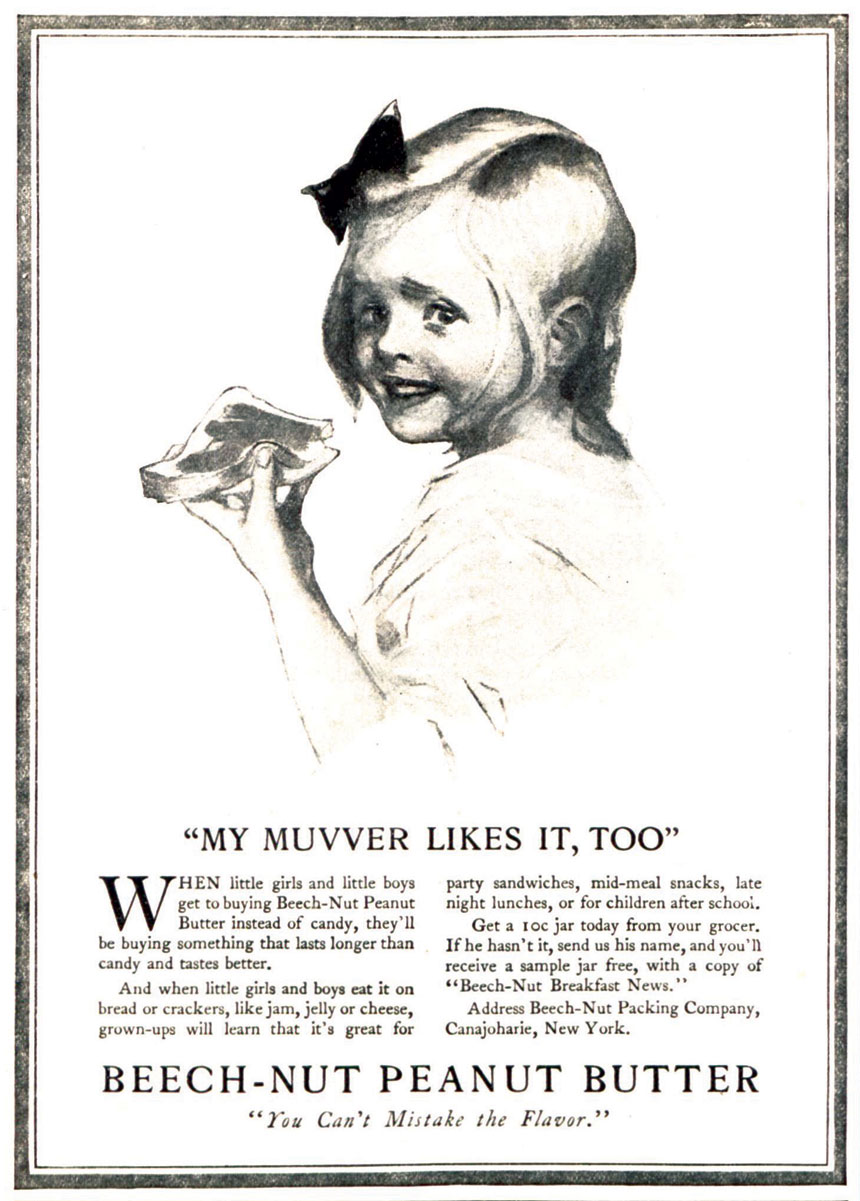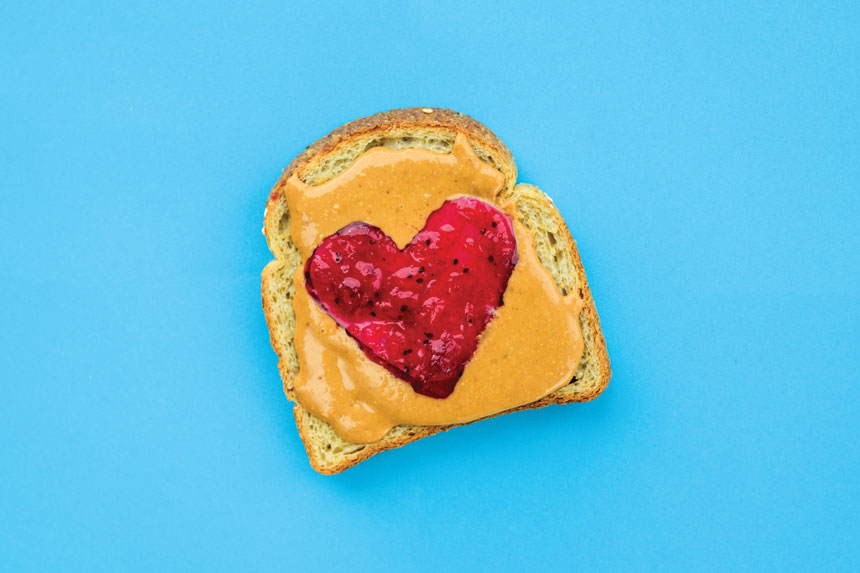If there is a truly American food — one that hasn’t been borrowed from another culture’s culinary tradition and transformed — then the peanut butter and jelly sandwich is probably it.
According to some estimates, the average American will consume nearly 3,000 peanut butter and jelly sandwiches in their lifetime; if those sandwiches were stacked on top of each other, they’d form a delicious, precarious tower taller than the Statue of Liberty. And it’s not just kids who love PB&J — that same survey, commissioned by Peter Pan peanut butter, revealed that the average American adult eats three peanut butter and jelly sandwiches a month. Meanwhile, sales of Uncrustables, frozen pre-made PB&Js with crimped edges that seal in the gooey insides, topped $650 million in the last fiscal year.
But as natural a combination savory, salty peanut butter and bright, sweet jelly seems to Americans, the rest of the world is a bit wary — the PB&J is really found only in the U.S. And how we got the PB&J, a relative newcomer to the culinary world, is the result of some serious American ingenuity.
Let’s start with the “PB” — peanut butter. The peanut, famously, is neither a pea nor a nut, but a legume. Originally domesticated in very pre–Columbian South America, the peanut surfed around the world on the first wave of globalization. It was cultivated in the American South throughout the 18th century, although it was largely used for animal feed and not human consumption. By the middle of the 19th century, however, peanuts were being examined with a much hungrier eye; cheap and full of calories, they became a staple of the Civil War-era diet.
According to the National Peanut Board, peanut butter first debuted at the 1904 St. Louis World’s Fair. This, however, isn’t entirely accurate — though peanut butter did make a fine showing there, attracting the attention of major foods manufacturers, it had been around in the U.S. for at least a decade prior. Jon Krampner, author of Creamy and Crunchy, a history of peanut butter, credits St. Louis businessman George Bayle with the invention of peanut butter in 1894; but Bayle wasn’t peanut butter’s real champion. That would be cornflakes inventor and enema fan Dr. John Harvey Kellogg, who patented his own method for “preparing nut meal” in 1895 and introduced it to his well-heeled clients as a gentle-on-the–bowels, protein-rich health food. A devotee of Fletcherism, a diet fad that involved chewing one’s food to mush to aid digestion, Kellogg served his easy-to-stomach peanut butter to patients at his Battle Creek Sanitarium. (Notably, Dr. George Washington Carver, the famous turn-of-the-century peanut-pushing botanist, found some 300 new uses for peanuts. He didn’t invent peanut butter.)
Like everything from eggs to avocados after it, peanut butter was treated as a kind of miracle food: Rich in vitamins, protein, and fat and high in calories, it was a nutritionally dense energy bomb, particularly important at a time when people were increasingly suffering from food insecurity. In 1897, the Washington, D.C., Evening Star declared peanut butter an excellent, even superior, substitute for dairy butter that could be used in gravies, sauces, and soups, and that it was “well designed for the use of vegetarians who strenuously object to anything animal.”
Housekeeping pages from newspapers and magazines from the early part of the 20th century abound in peanut butter recipes that sound frankly bizarre, like a banana and apple salad served over lettuce with a peanut butter dressing, or a peanut butter “loaf” recipe involving two cups of chopped olives and a teaspoon of onion juice. Because of (or perhaps in spite of) those kinds of suggestions, the popularity of peanut butter rose precipitously in the first part of the 20th century: 1907 saw 34 million pounds of peanut butter produced, a massive increase on the 2 million of 1899, as Krampner notes.

Given that early recipes suggested applying peanut butter to virtually everything, it can’t be too surprising that the peanut butter and jelly sandwich made a relatively early appearance. Large-scale jam and jelly production took off in a big way in the 19th century, as the Industrial Revolution got into full swing and the cost of sugar plummeted.
According to Brian Horowitz, sandwich historian, one of the earliest mentions of a peanut butter and jelly sandwich appeared in an article on “Peanuts and Pralines” in a 1901 Boston culinary magazine. The writer, Julia Davis Chandler, suggested sandwiching peanut butter with a jelly of your choice between slices of “very thin bread,” adding, “The combination is delicious and, as far as I know, original.” Whether or not it was really Chandler who introduced the peanut butter and jelly sandwich to a grateful nation is unclear, although the combination was delicious. It wasn’t yet, however, hugely popular, and it certainly didn’t enjoy the ubiquity that it soon would.
That would require a few more developments. At the time of Chandler’s writing, peanut butter was still difficult to make, requiring either a mortar and pestle or a meat grinder, and was somewhat costly. The invention of a peanut-butter-making machine in 1904, writes Horowitz, would solve both of those problems. Secondly, peanut butter at that time was as natural as you can get: The solids would easily separate from the oil at room temperature, meaning that it spoiled more quickly and didn’t travel well. In the 1920s, the development of hydrogenated oils led, Krampner notes, to the industrialization of peanut butter production and, of course, to the substance’s increased availability and decreased price.
So jelly was readily available, and peanut butter was now in jars — that just left bread. In 1927, Iowa native and former jeweler Otto Frederick Rohwedder designed his automatic bread-slicing machine, revolutionizing the baking industry; by 1933, fully 80 percent of the bread made by American bakeries was sold pre-sliced, cut by his machine. And suddenly, what was already a calorific, mostly nutritional snack became a whole lot more convenient.
PB&J initially found its home in the lunch bags (and hearts) of American children: In 1939, the New York School Board reported that peanut butter and jelly was the most popular sandwich among the 119,000 children who received free school lunches each day. But as those children grew into adults and left school, they took their PB&Js with them — everywhere.
According to the National Peanut Board, PB&J served in World War II as part of soldiers’ rations. In 1961, the Kreese family of Long Island spent 151 hours in a bomb shelter fitted with a large picture window, through which the family could be seen eating “large quantities of peanut butter and jelly and crackers” at the Roosevelt Field Shopping Center. On August 28, 1963, 250,000 people marched on Washington to demand jobs and civil rights and to hear Dr. Martin Luther King Jr. deliver his famous “I Have a Dream” speech, and according to a New York Times article from the Sunday before the march, organizers in Harlem recommended marchers bring them. In 1967, Dunkin’ Donuts introduced a peanut butter and jelly doughnut.
Peanut butter sales took a dip in the 1980s and ’90s, Krampner writes, largely due to health concerns: Fat and calories, initially peanut butter’s draw, had become dietary boogeymen. Jelly, often loaded with sugar, was no better. And there was another trend — as the number of children living with peanut allergies rose precipitously in the 1990s, many school districts began banning nuts in lunches.
But despite those issues, the popularity of PB&J never really waned. Sales of peanut butter rose again during the cash-strapped years of the 2007-2009 recession in America, largely because it remains a cheap and protein-rich source of calories. PB&J also enjoyed a boost during the pandemic. While undoubtedly some of that increase was due to the fact that children, homebound during nationwide lockdowns, were largely eating lunches at home, some of it certainly had to do with what PB&J represents to Americans — comfort.
And that’s because the final ingredient in a PB&J is, of course, nostalgia.
Linda McRobbie’s work has appeared in The Guardian, The Boston Globe, and others. She is the author of Princesses Behaving Badly. For more, visit lindarodriguezmcrobbie.com.
This article is featured in the September/October 2023 issue of The Saturday Evening Post. Subscribe to the magazine for more art, inspiring stories, fiction, humor, and features from our archives.
Become a Saturday Evening Post member and enjoy unlimited access. Subscribe now




Comments
Bindy-
You can enter our limerick contest on our website by clicking on the ‘Limerick Contest’ link at the bottom of our homepage, or here: https://www.saturdayeveningpost.com/limerick-contest/
There is a new limerick with each issue of the magazine, every two months.
I am a limerick writer. I understand the Post does limerick contests. How can I enter?
What an interesting history of the sandwich . I had no idea. I sometimes have one for breakfast, just to eat something different. For a snack, I sometimes eat several spoonfuls of Peanut butter in the afternoon.
I love the venerable p,b&j sandwich, but haven’t had one in decades, for a simple reason:
I can’t find jelly anywhere. I can find jam, preserves, “fruit spread,” but jelly? If I ever found any, I’d be almost as shocked as if I’d found the Ark of the Covenant.
I’m not writing from Kazakhstan or Malaysia. I’m writing from the forbidding lands of quintessential America, Indiana. And I haven’t been able to find actual jelly in many, many years.
I took a peanut and jelly sandwwich every day for lunch in high school. Our whole family had peanut butter sandwches for snacks just about every day. When We got married my husband and I ate peanut butter and pineapple cream cheese sandwiches 4-5 times a week… I still l still love them. My children and grandchildren and now great grandchildren are all peanut butter afficionados! Love ‘em
When I attended my high school reunions
people would come up to me to find out if I still are peanut every day !!
Love my PB&Js so do my kids.
But husband, his brother and his mother are digusted by peanutbutter. Could it be genetic trait or a family preference?
Don’t know and don’t really care as long as I have my peanutbutter and PB&Js!
Very interesting!
Great comprehensive article on the enduring popularity of this uniquely American dynamic duo, Linda!